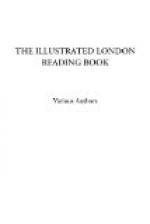Aroused by Gelert’s
dying yell,
Some slumberer
waken’d nigh:
What words the parent’s
joy can tell,
To hear his infant
cry!
Conceal’d beneath a
mangled heap,
His hurried search
had miss’d:
All glowing from his rosy
sleep,
His cherub boy
he kiss’d!
Nor scratch had he, nor harm,
nor dread;
But the same couch
beneath
Lay a great wolf, all torn
and dead—
Tremendous still
in death!
[Illustration: SYRIAN WOLF.]
Ah! what was then Llewellyn’s
pain,
For now the truth
was clear;
The gallant hound the wolf
had slain
To save Llewellyn’s
heir.
Vain, vain was all Llewellyn’s
woe—
“Best of
thy kind, adieu!
The frantic deed which laid
thee low,
This heart shall
ever rue!”
And now a gallant tomb they
raise,
With costly sculpture
deck’d;
And marbles, storied with
his praise,
Poor Gelert’s
bones protect.
Here never could the spearman
pass,
Or forester, unmoved;
Here oft the tear-besprinkled
grass
Llewellyn’s
sorrow proved.
And here he hung his horn
and spear;
And oft, as evening
fell,
In fancy’s piercing
sounds would hear
Poor Gelert’s
dying yell.
W. SPENCER.
* * * * *
THE GREAT WALL OF CHINA.
[Illustration: Letter T.]
The important feature which the Great Wall makes in the map of China, entitles this vast barrier to be considered in a geographical point of view, as it bounds the whole north of China along the frontiers of three provinces. It was built by the first universal Monarch of China, and finished about 205 years before Christ: the period of its completion is an historical fact, as authentic as any of those which the annals of ancient kingdoms have transmitted to posterity. It was built to defend the Chinese Empire from the incursions of the Tartars, and is calculated to be 1500 miles in length. The rapidity with which this work was completed is as astonishing as the wall itself, for it is said to have been done in five years, by many millions of labourers, the Emperor pressing three men out of every ten, in his dominions, for its execution. For about the distance of 200 leagues, it is generally built of stone and brick, with strong square towers, sufficiently near for mutual defence, and having besides, at every important pass, a formidable and well-built fortress. In many places, in this line and extent, the wall is double, and even triple; but from the province of Can-sih to its eastern extremity, it is nothing but a terrace of earth, of which the towers on it are also constructed. The Great Wall, which has now, even in its best parts, numerous breaches, is made of two walls of brick and




